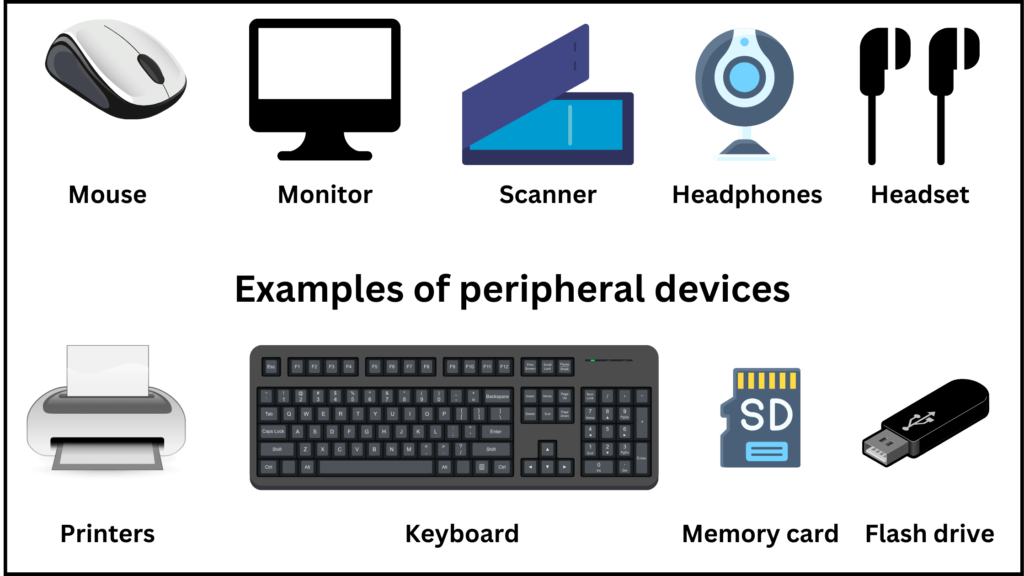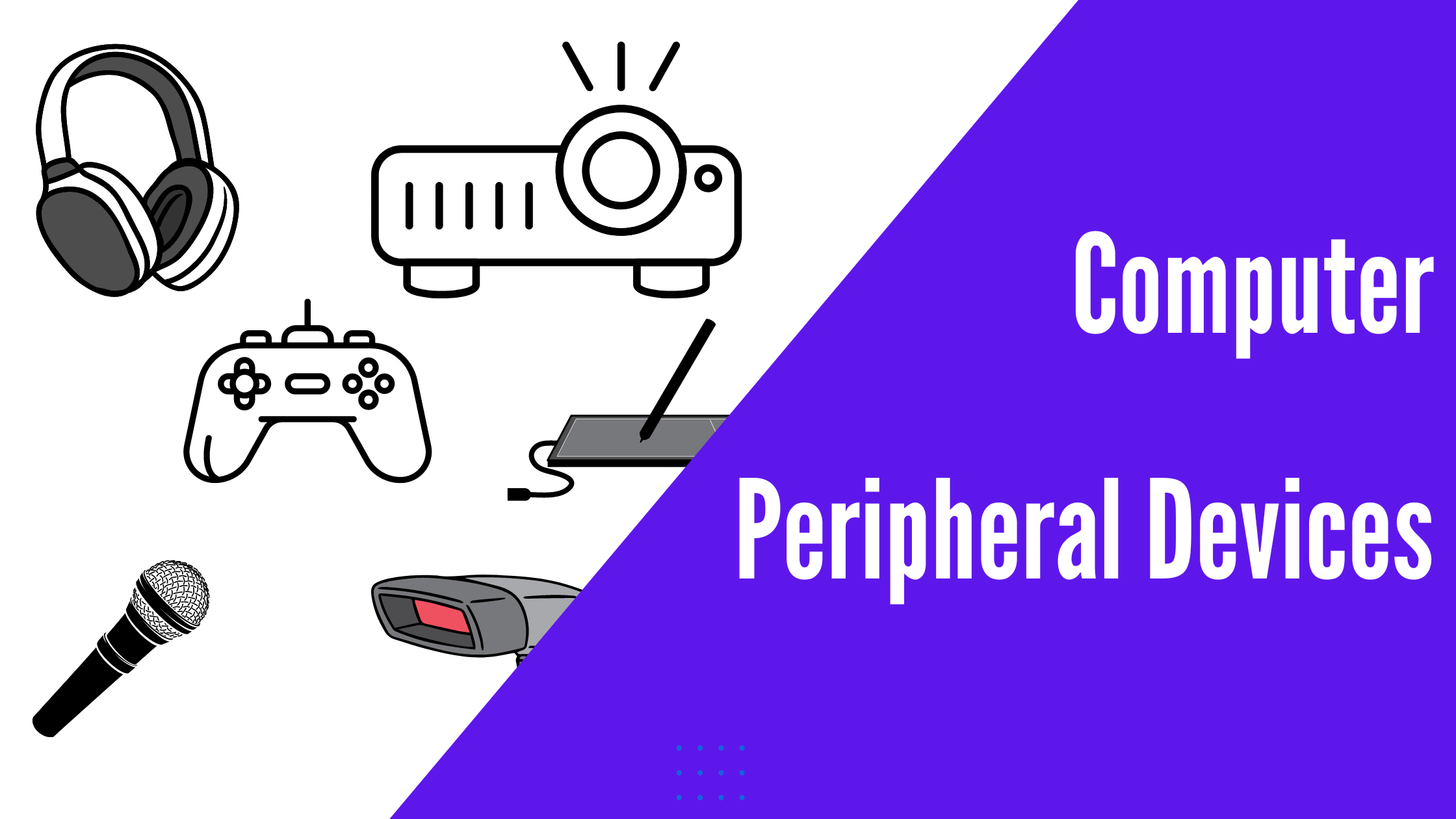Last updated on July 24th, 2025 at 01:34 pm

If the question, “What are peripheral devices?” has you stumped, you have come to the right place. Regardless of the type of computer you are using, there is a good chance that you have used a peripheral device before.
Keep reading to learn:
- What peripheral devices are;
- What are computer accessories;
- Types of peripheral devices; and
- Examples of peripheral devices and their functions.
What are peripheral devices?
Peripheral devices are computer accessories or add-ons that extend the functionality of the computer. They allow you to interact with the computer in many different ways. These devices connect to the computer’s system unit via its many ports.
What are computer accessories?
Computer accessories are additional devices associated with computer use. They make it easier to use the computer.
⚠️While peripheral devices are computer accessories, not all computer accessories are peripheral devices. For instance, a mouse pad is a computer accessory but not a peripheral device.
Types of peripheral devices
Peripheral devices come in three main groups:
- Input devices;
- Output devices; and
- Storage devices.
While all of these devices allow us to interact with the computer, removing them will not stop the computer from working. This is why they are called peripheral devices or add-ons.
Some of these devices are more important for the day-to-day use of computers than others. For instance, while a computer monitor falls under this group of computer add-ons, it is necessary for the day-to-day operations of your computer.
A printer, on the other hand, is one of the add-ons that is not necessary for the day-to-day operation of the computer.
Examples of peripheral devices found in our homes or workplaces
Below are some examples of popular add-ons found in our homes or workplaces. Go through the list, and you will realize that their primary purpose is to allow us to interact with the computer.

Input devices
Some peripheral devices that fall under the heading of input devices are:
- Mouse;
- Keyboard;
- Scanners;
- Barcode reader;
- Joystick;
- Touchpad; and
- Microphone.
Output devices
The following peripheral devices are output devices:
- Projectors;
- Monitors;
- Printers; and
- Speakers.
Storage devices
Some storage devices that are also peripheral devices are:
- Flash drives;
- External hard drives;
- Memory cards; and
- Magnetic tape.
Now that you have explored the categories and examples of add-ons, let’s look at their functions.
Functions of peripheral devices
Each group of these computer accessories shares a common function.
The input devices allow you to enter information into the computer. You may do so by typing with your keyboard, scanning barcodes with the barcode reader, or using the mouse to point and click. Some, such as the microphone and scanner, allow you to enter information in other formats, such as audio files or images.
The primary purpose of the output devices, on the other hand, is to allow you to access information stored in the computer. However, some, such as the monitor and projector, also help you view the programs and data on the computer to make it easier for you to interact with it.
You will agree that without the monitor or projector, you will not be able to see and, therefore, will not be able to interact effectively with the computer.
When we speak of storage devices as tools that extend the functionality of the computer, we are not talking about the internal hard drive or solid-state drive. We are talking about the storage devices that need to be connected to the external computer ports.
These storage devices store information for future use and allow us to transfer information from one computer to another.
What is a peripheral device driver?
A peripheral driver is a software program that is used to communicate between the peripheral device and the computer system.
How do peripheral devices connect to a computer?
Peripheral devices connect to the computer via wired and wireless ports located at the back of the system unit.
Do I need multiple peripheral devices?
Yes. Utilizing multiple peripheral devices with a desktop computer or even a laptop will enhance your experience when using your computer. Here are reasons why you might need multiple peripheral devices:
Multiple monitors provide enhanced productivity
Ergonomics will be improved with an external keyboard and mouse.
Specialized devices are used to input data efficiently.
Audio and video communication enhancement your computer usability. They do this by allowing you to access information on different screens at the same time,
How can I tell if a peripheral device is compatible with my computer?
To tell if a peripheral device is compatible with your computer, here are some helpful steps that should be taken:
Make sure the device can connect to your computer.
Ensure your system reaches the requirements for connectivity.
Have the necessary drivers and software installed.
Test the device with your computer to ensure compatibility.
Where can I find drivers for my computer peripherals?
Drivers for peripherals can be found in various channels. Here are some common channels where drivers are found:
Windows update is the most common of them, the reason being that the drivers are installed immediately by the computer if your settings permit. This allows all the current drivers that the peripherals have to update to their more advanced form. Windows updates can be found in your computer settings.
Manufacturer websites are also another common place to find drivers for the various peripherals available to you.
Dell, HP, and Realtek are companies that create their technology, so they would have the drivers for various peripherals on their websites.
The device manager is another place where drivers can be found.
What is the difference between a wired and wireless peripheral?
Wired peripheral devices are those devices that use a physical connection to your system unit. Wireless peripheral devices, on the other hand, connect to your computer wirelessly. Example with the use of WiFi or Bluetooth.
What are some factors to consider when choosing between a wired and wireless peripheral device?
There are multiple factors to consider when choosing between a wireless and wired peripheral device. Such factors include quality, reliability, performance, and what it will be used for.
Wired peripherals are ideal for gaming or designing, as these activities require fast response time, which is provided by the direct connection.
Wireless peripheral devices have advanced a great deal over the years; some say that they saw a tremendous growth spurt. However, they tend to be less responsive than wired devices due to the dependence on less reliable wireless connections.
What are some examples of specialized computer peripherals?
Some specialized peripherals are:
Braille keyboards are used by the visually impaired.
3D mouse used by professionals in the field of graphic designing, architecture, etc.
Graphic tablets, equipped with a touch pen, are popular tools that artists and designers use.
Adaptive game controllers, as the name suggests, are commonly used by gamers. They make gaming more accessible for physically disabled individuals.
 Skip to content
Skip to content 